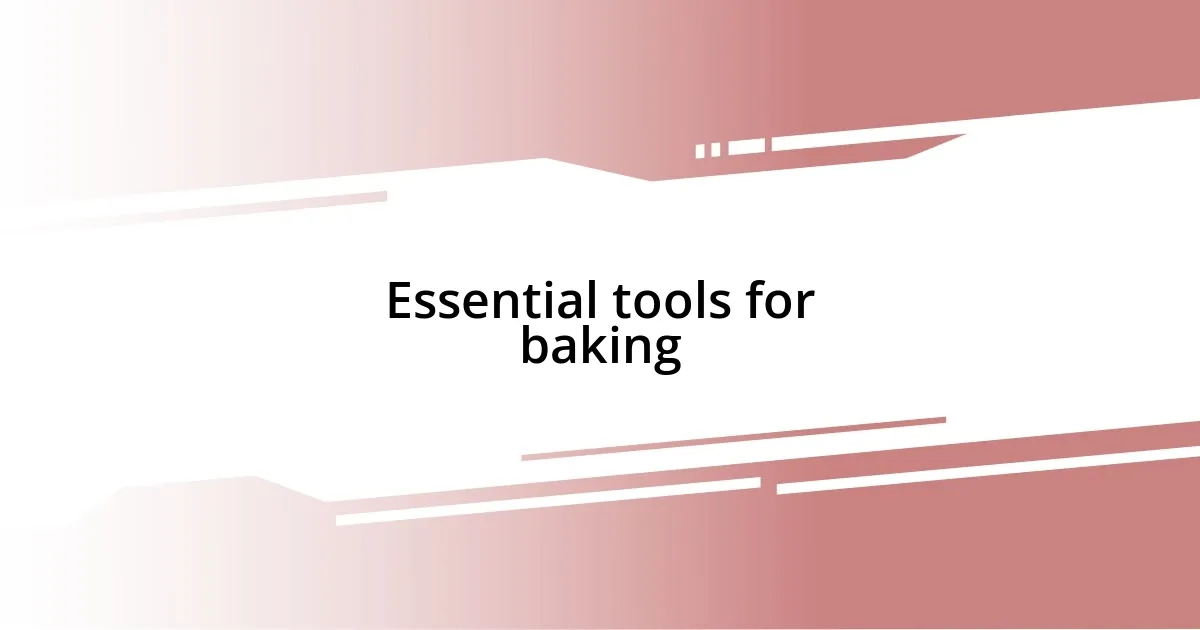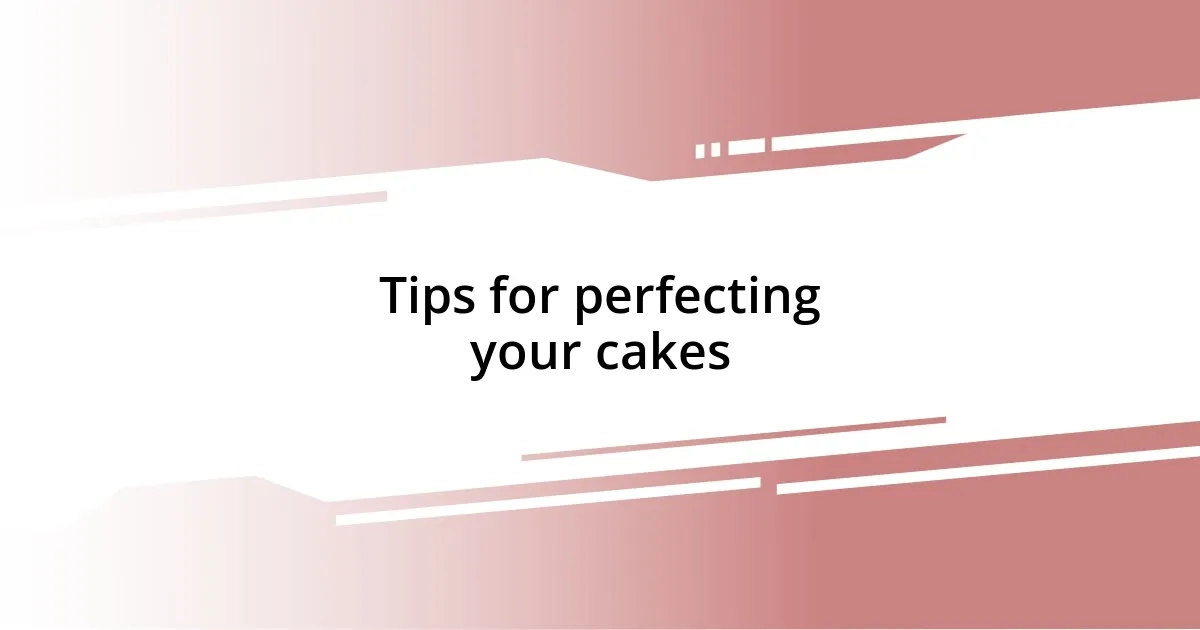Key takeaways:
- Childhood memories of baking chocolate cakes instilled a deep appreciation for the comfort and joy they bring during family gatherings.
- Understanding and experimenting with chocolate layers enhances flavor, texture, and visual appeal, making cakes more enjoyable.
- Choosing the right cake recipe involves factors like flavor combinations, skill level, and occasion to ensure successful baking experiences.
- Utilizing essential baking tools and techniques, such as using a stand mixer and keeping ingredients at room temperature, significantly improves cake quality.

My inspiration for chocolate cakes
One of my earliest memories tied to chocolate cake is from my childhood, sitting at the kitchen table with my mom blending cocoa and sugar. The moment the rich scent filled the air, it felt like magic—what’s more enchanting than the scent of chocolate wafting through your home? I still remember the anticipation, waiting for that warm slice topped with a glossy chocolate ganache.
As I grew up, I found chocolate cakes to be a comforting presence during family gatherings. There’s just something profound about sharing a slice with loved ones, isn’t there? I can still picture my aunt’s beaming face as she presented her signature cake, and I’ve often wondered, does the act of baking something so indulgent create a deeper bond?
My inspiration also comes from visiting bakeries, where the intricate chocolate designs seem almost like art. Seeing creativity in a cake makes me think—how can I elevate my own skills? It drives me to experiment, from adding unexpected flavors to mastering layering techniques, always chasing that inner spark that started with a simple bowl of batter.

Understanding chocolate layers
Understanding the nuances of chocolate layers is essential for any cake enthusiast. Each layer brings its own character, whether it’s a rich, dark chocolate or a lighter milk variation. I remember the first time I experimented with varying chocolate types in a layered cake; the combination created a depth of flavor that thrilled my taste buds and completely transformed the usual chocolate experience into a decadent journey.
Layering is not just about flavor but also texture. Adding different elements like crispy wafers or creamy mousse can elevate the overall experience. I once made a cake with alternating layers of fudge and airy whipped chocolate ganache. The contrast was stunning! I could hardly believe how a simple modification turned my cake into a texture sensation that guests couldn’t stop raving about.
In my adventures, I’ve also learned that the beauty of chocolate layers lies in their visual appeal. Imagine cutting into a cake with visibly distinct layers, each showcasing its own rich chocolate hue. It’s like unveiling a masterpiece! The first time I served one such cake at a gathering, I was met with gasps of admiration before anyone even took a bite. That moment made me appreciate how chocolate layers aren’t just delicious—they’re a feast for the eyes too.
| Chocolate Type | Flavor Profile |
|---|---|
| Dark Chocolate | Intense and rich, with a hint of bitterness |
| Milk Chocolate | Sweet and creamy, often lighter |
| White Chocolate | Very sweet with a buttery taste, less chocolatey |
| Chocolate Ganache | Luxurious and silky, enhances moisture |

Choosing the right cake recipe
Choosing the right cake recipe can feel daunting, especially with so many options out there. I often find myself drawn to recipes that resonate with my own memories—like those that require a simple chocolate sponge or rich chocolate cream. The first time I picked a recipe that included espresso powder, I was amazed at how much it amplified the chocolate flavor, bringing a depth that I had never truly appreciated before.
Here’s a quick checklist to help you choose the right cake recipe:
- Flavor Combinations: Consider flavors that you love or want to explore; chocolate works well with fruits, nuts, or even spices like cinnamon.
- Skill Level: Be honest about your baking abilities. If you’re just starting out, opt for simpler, straightforward recipes.
- Texture Preference: Think about whether you prefer a light sponge or a denser cake. Each will provide a different experience.
- Occasion: Your recipe should reflect the event. A formal gathering might call for an elegant layered cake, while a casual get-together could work with a more rustic version.
- Ingredient Availability: Check if you can easily find the ingredients required in your kitchen or nearby store.
Trust me, the right recipe can make all the difference! When I used a recipe that included sour cream for the first time, the texture was unbelievably moist—everyone at the dinner couldn’t stop asking for the recipe. It’s those little surprises that continue to fuel my passion for baking!

Essential tools for baking
When it comes to baking, the right tools can make all the difference, and having a well-equipped kitchen is essential. A good set of measuring cups and spoons is non-negotiable; I still remember the time I tried to wing it with my grandmother’s old cup, only to end up with either a dry cake or a gooey disaster. It’s amazing how a simple thing like precision can influence the outcome of your baking!
Another indispensable tool is a good stand mixer. The first time I used one, I felt like I could conquer the baking world. Mixing batter becomes effortless, and it saves you from the shoulder workout that comes with whisking by hand. Plus, it frees up your hands for other tasks—like sneaking chocolate chips from the bag when no one’s looking! Who doesn’t love creating a little joy in the kitchen?
Finally, I can’t stress enough how versatile a quality baking pan can be. My go-to is a heavy-duty cake pan, which ensures even baking and prevents those dreaded burnt edges. I won’t forget when I decided to bake my mom’s birthday cake in a flimsy pan—I learned the hard way that some things are worth investing in. Isn’t it fascinating how tools can shape our experiences and elevate our outcomes in baking?

Techniques for layering cakes
Layering cakes can transform a simple dessert into a stunning centerpiece, and there are several techniques I’ve picked up along my baking journey. One technique that has truly improved my cake skills is using a serrated knife to create even layers. The first time I attempted this, I was surprised by how much a meticulously leveled cake could elevate my presentation. It’s almost like giving your cake a fresh haircut, leaving it sleek and sophisticated!
Another trick I like to share is the addition of syrup between layers. I remember the first time I brushed simple syrup—just sugar and water—onto my chocolate layers. The cake became incredibly moist and flavorful while preventing those dreaded dry bites. Have you ever tasted a layered cake that seemed to melt in your mouth? That extra moisture is what brings that delightful texture to life.
Lastly, don’t underestimate the power of a sturdy filling! Deciding on a filling can sometimes feel overwhelming, considering how many options are out there. Initially, I played it safe with classic buttercream, but once I ventured into flavored ganache and fruit preserves, it felt like a whole new world opened up. Each filling layer adds not just flavor, but a lovely surprise in the midst of each bite. What’s your favorite filling? I’d love to hear about it, as it might inspire my next layer!

Decorating your chocolate layered cake
Decorating your chocolate layered cake is where your personality truly shines! I remember the first time I attempted to decorate a cake; I was nervous and excited all at once. After frosting with a velvety chocolate ganache, I sprinkled some crushed cookies on top and stepped back to admire my work. It was at that moment I felt like an artist, transforming something simple into a spectacle. Who knew that just a bit of creative flair could make such a delicious difference?
One technique I adore is using fresh berries and mint leaves as garnishes. The vibrant colors contrast beautifully with the dark chocolate layers, creating a feast for the eyes. I can still recall the smile on my friend’s face when she saw a cake adorned with those juicy raspberries—it’s like the cake told a story of lushness and celebration! Have you ever noticed how the right garnish can elevate a dessert from ordinary to extraordinary? It really does impact the experience!
Finally, let’s not forget about the fun of creating a drizzle! Whether it’s white chocolate or caramel, a simple drizzle can add elegance and drama to your cake. I once attempted a swirly pattern that turned out a bit too abstract, but the laughter that followed made it one of my favorite baking memories. Sometimes, it’s those little quirks that give our creations character. How do you like to add your special touch?

Tips for perfecting your cakes
One of the most crucial tips I can share is to keep your ingredients at room temperature. I learned this the hard way during a baking session that turned into a mini disaster. I had butter straight from the fridge, and when I creamed it with the sugar, the mixture just wouldn’t come together. It made me realize that allowing eggs, milk, and butter to warm up can make a remarkable difference in the texture of your batter. Have you ever forgotten this step and paid the price? Trust me, it’s worth the extra planning!
Another great tip is to avoid overmixing your batter. In my earlier days of baking, I wanted everything to be perfectly blended, but I ended up with dense cakes instead of fluffy ones. It’s almost as if I was giving my cake a workout! Now, I gently fold my ingredients until combined, and it’s amazing how much lighter and airier the cakes turn out. So, when you’re mixing, ask yourself if you really need those extra few seconds—your taste buds might thank you later!
Lastly, I recommend investing in an oven thermometer. The first time I used one, it completely changed my baking game. My oven’s settings were off, and I had been blind to it for ages. With the thermometer, I learned that precision is key to achieving that perfect rise and even baking. Have you ever pulled a cake out only to find it uneven? I can relate! This little tool has helped me embrace the science of baking and create cakes that not only look beautiful but also taste incredible.














